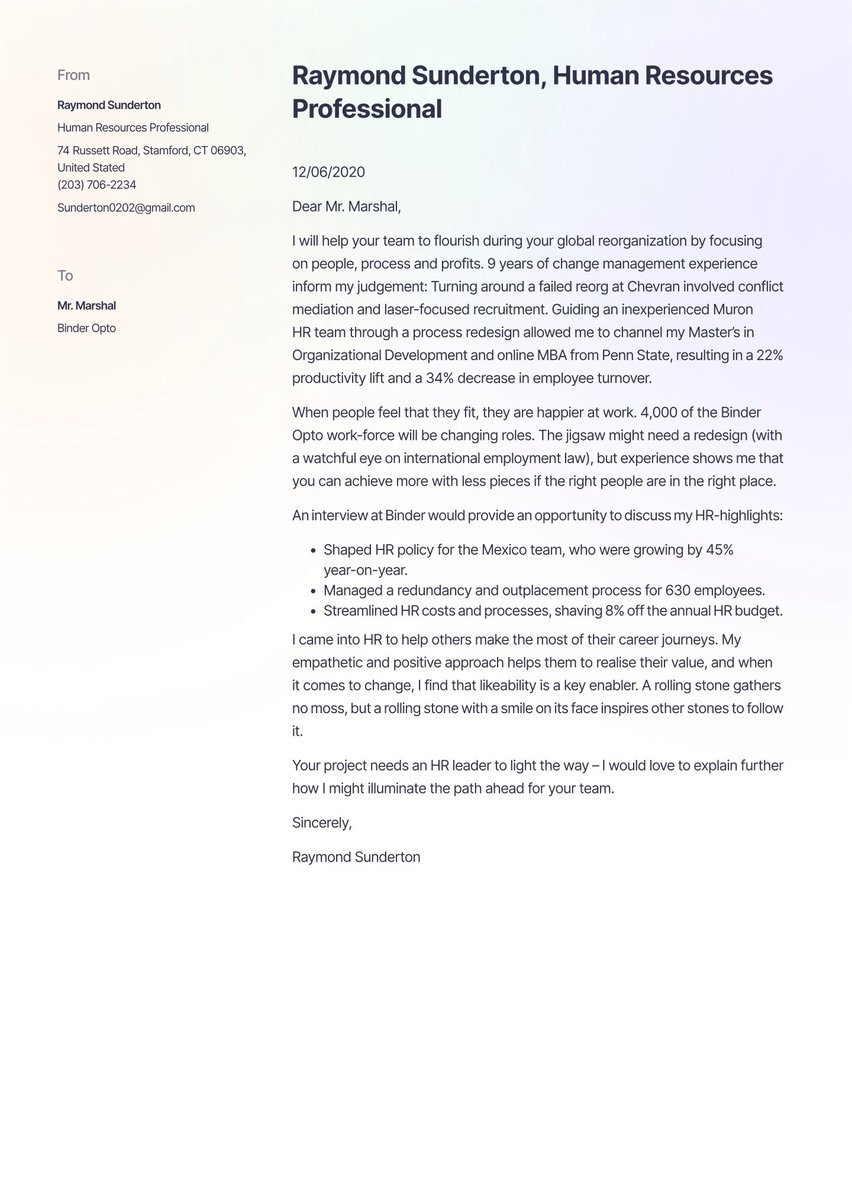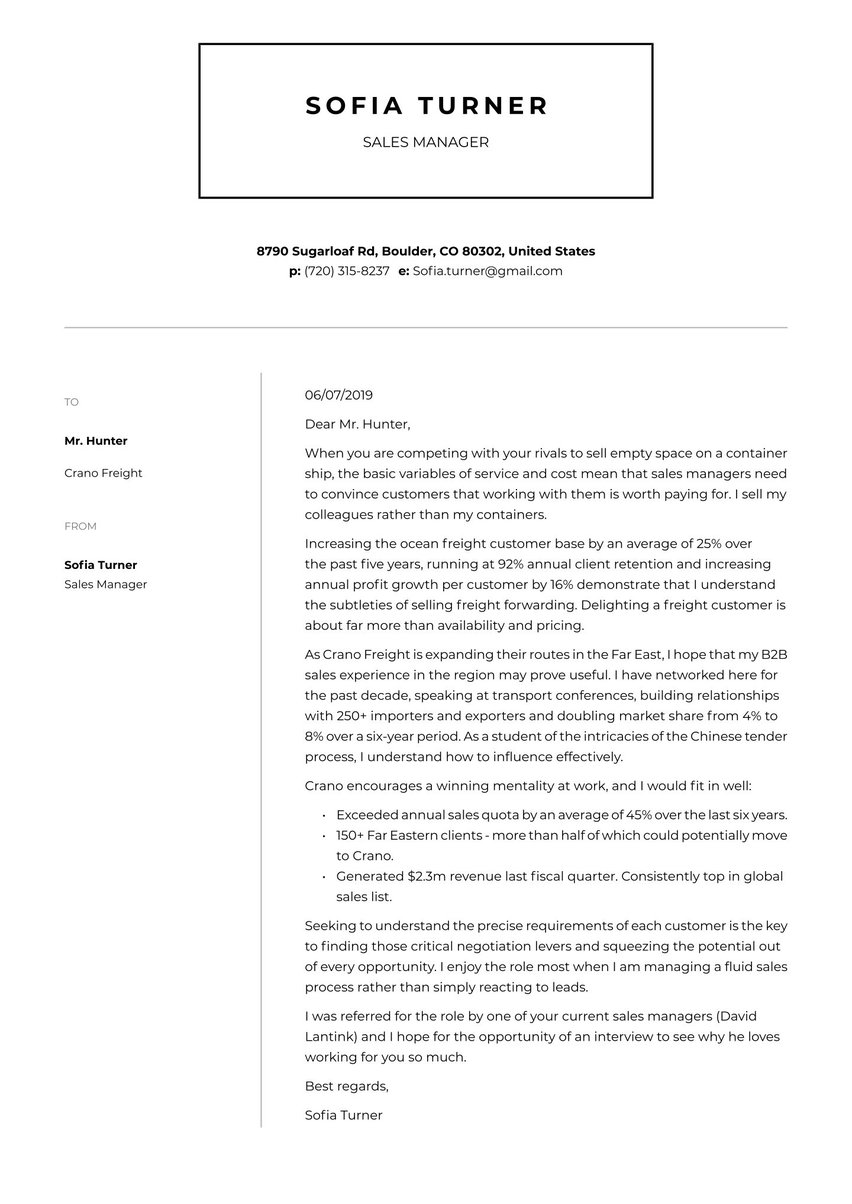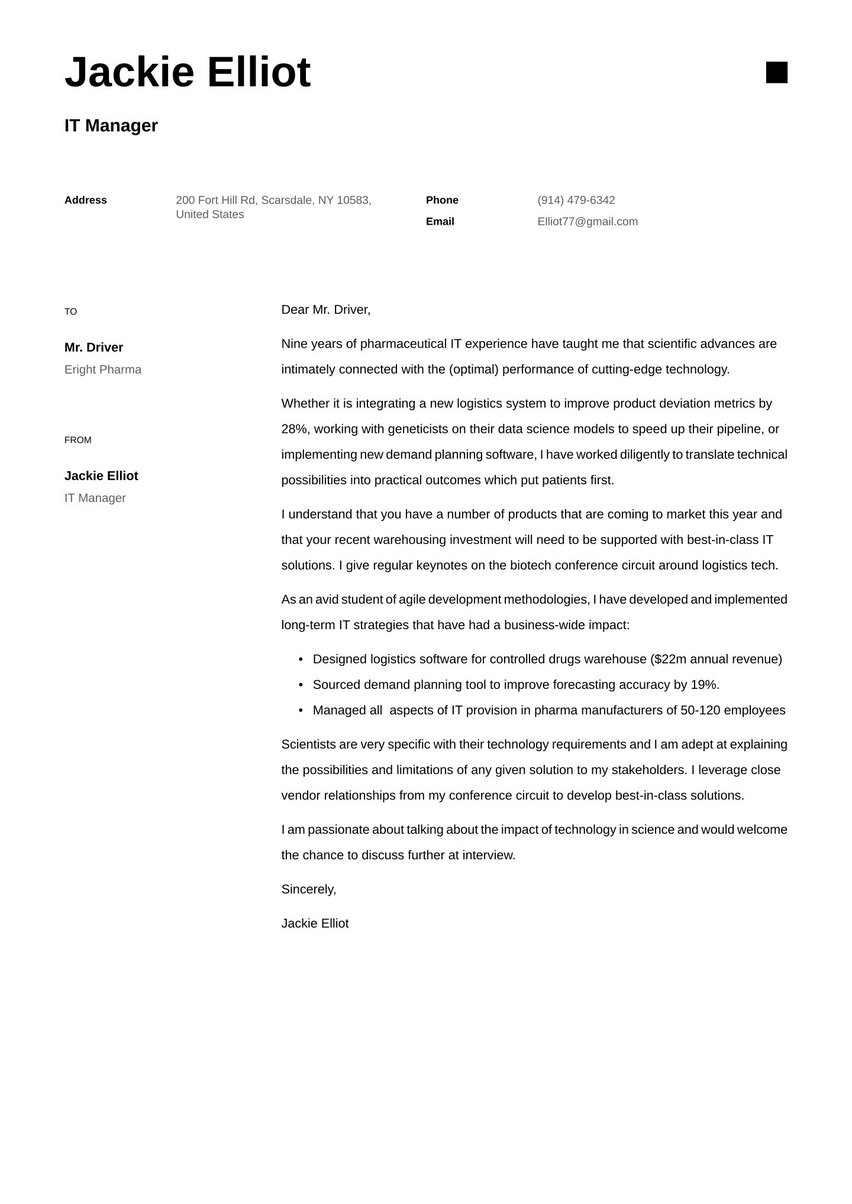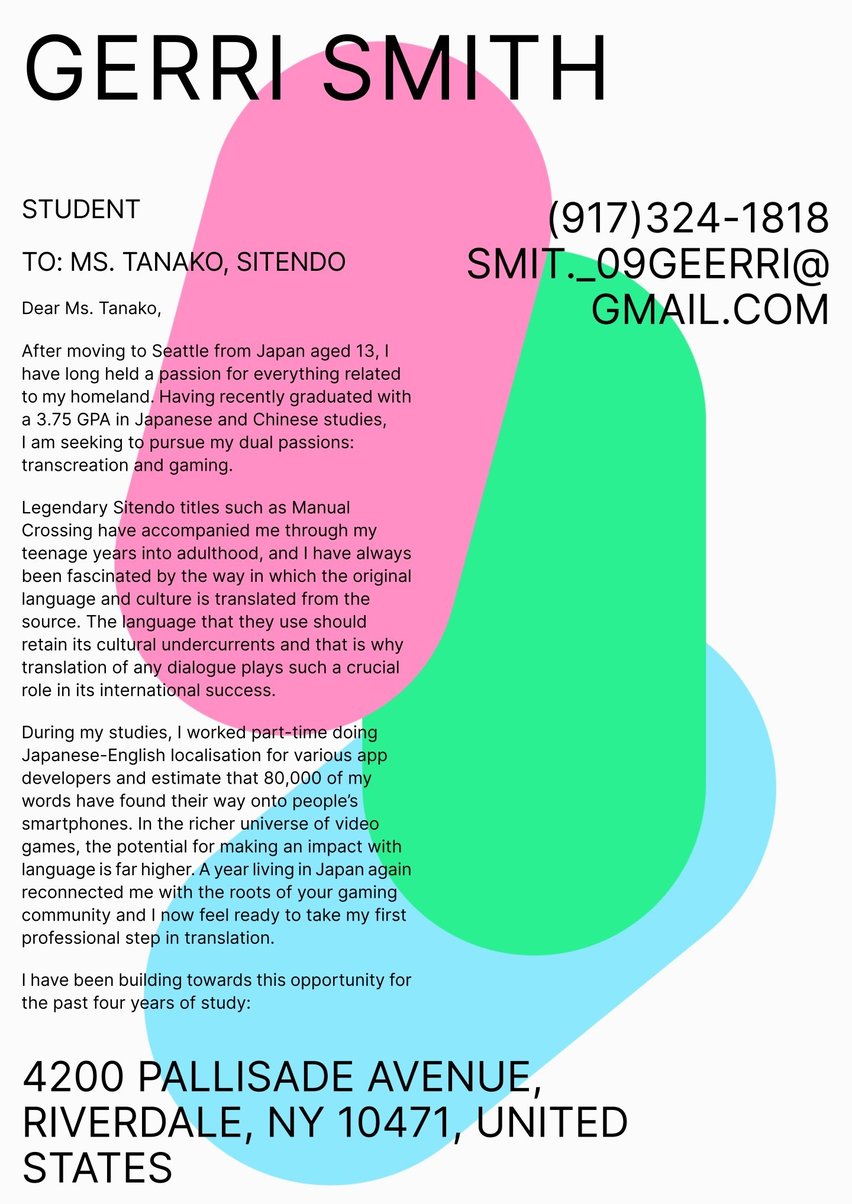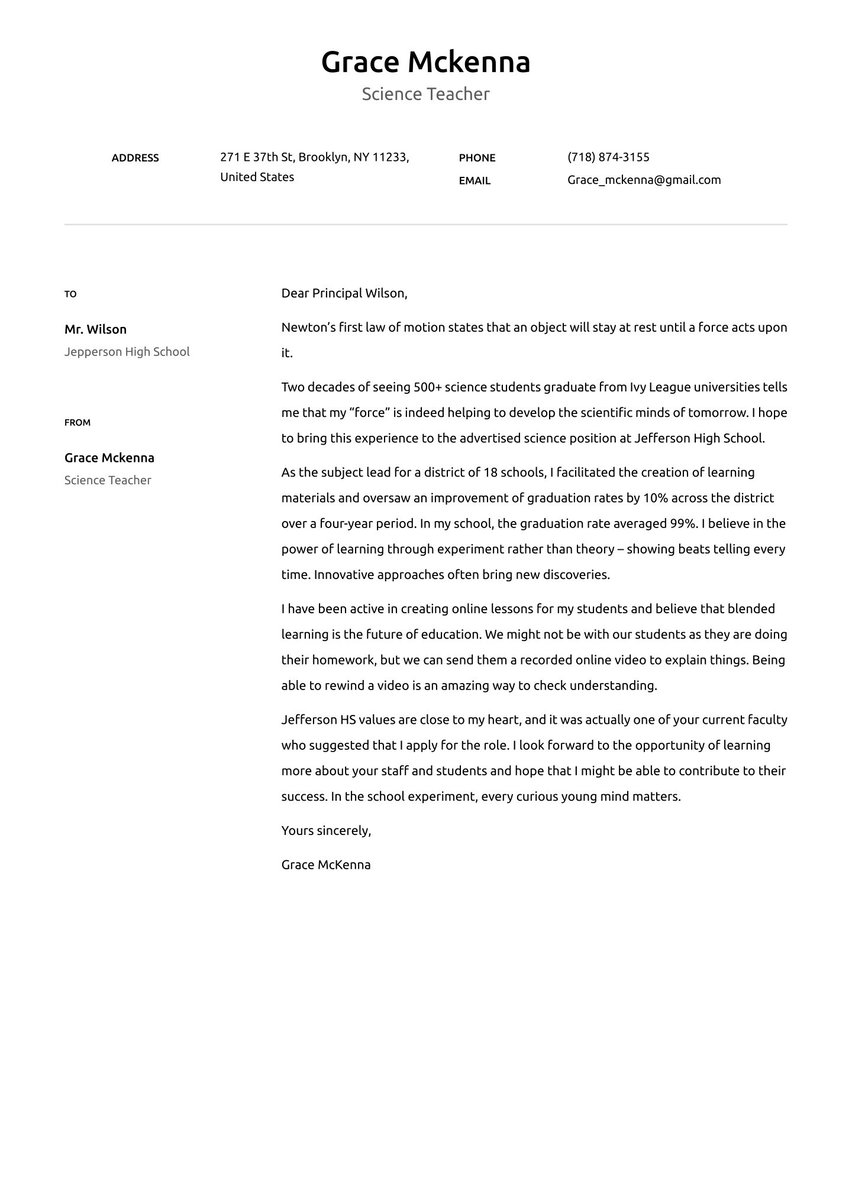You might be an expert at writing code, but writing a great cover letter is a different sort of challenge.
Far too often, candidates don’t spend the time needed to craft an impressive cover letter. That’s why most cover letters are dull, boring, and lackluster.
If you struggle with generating a cover letter that is both efficient and impressive, you’re in luck. We look at the tools you need to truly stand out and capture the attention of hiring managers.
Software engineer full text-only cover letter example
Dear Mrs. Wanamaker,
After eight years of software development experience in the ecommerce operations of two leading online fashion retailers (averaging 11 million+ monthly visits), I hope to bring my web development and systems architecture skills to Banton.
The majority of my career has been spent maintaining ESB applications and ensuring the smooth operations of the ecommerce back end. I am proficient at understanding the needs of the business and putting the customer experience first while keeping an eye on budgetary constraints. After reinvigorating the supplier base in 2019, we achieved a 13% annual cost saving while decreasing website bugs and coding errors by 35%.
My highest profile project came when I designed, developed and implemented the architecture of an award-winning virtual store that allowed customers to superimpose their image onto our products. From initial requirement gathering to design, coding, testing and roll-out, I project managed every aspect. The application increased LFL sales by 18%.
Prior to my retail experience, I spent a decade in a software consultancy, so my technical experience is broader than just ecommerce. This has proved useful for many non-retail requirements. I am proficient in Windows, Unix and Linux platforms, as well as fluent in nine programming languages (including C, C++, VB, Java, Perl and SQL).
My computer science degree from CalTech formed the foundation of my career, but I have taken every opportunity since to take over 60 online courses and certifications. You could say that I am somewhat addicted to improving my software skills.
I look forward to hearing about your development plans and hope that an interview might allow me to expand on how my skills could contribute.
Yours sincerely,
Steven Frost
Sections of a software engineer cover letter.
Creating a strong cover letter for a software engineer role is like debugging your code before deployment—every detail counts! Each line of code needs to contribute to the final product.
Here are the key components of your cover letter:
- Cover letter header. Begin with a clean layout of your contact information and the date. It’s a subtle way to greet the reader before you dive in.
- Greeting. Now’s the opportunity to create a connection—address the hiring manager by name, showing that you’ve done your research.
- Introduction. Open with impact. Introduce yourself, express your excitement for the software engineer position, and grab their attention immediately.
- Body. This section is where you highlight the core of your journey. Present your relevant skills, accomplishments, and experience, demonstrating how they align with the company’s goals and values.
- Conclusion. Reinforce your qualifications and passion for the role, with a clear call to action to engage further.
- Signature. Sign off professionally with your full name to leave a lasting impression.
Keep it brief— no more than one page—while presenting your skills in a way that ties them into a compelling narrative that fits the company’s mission and technical needs.
The goal is to build a connection. Go beyond merely highlighting your qualifications. Showcase why you’re the right fit for the company’s engineering team.
Need more inspiration? View our other related cover letter examples from the technology sector:
Introduction of a software engineer cover letter
Recruiters are busy and their time is limited. That said, you want to capture their attention right away with a strong intro.
This not only piques the reader’s attention, but you stand out among the countless boring cover letters they read every day.
Start off with an enticing hook that is both exciting and relevant to the company.
Dear Mrs. Wanamaker,
After eight years of software development experience in the e-commerce operations of two leading online fashion retailers (averaging 11 million+ monthly visits), I hope to bring my web development and systems architecture skills to Banton.
Dear Mrs. Wanamaker,
I’m writing to apply for the software engineer position. I’m enthusiastic about programming and have worked on a few small projects. I’m confident that I can grow into this role and contribute to your team. I’m eager to learn more about your company and how I might fit in.
A great way to impress the reader immediately is by showcasing your impact with quantifiable results. In our example, Steven mentioned his experience working with an online fashion retailer averaging 11 million monthly visitors. This highlights his ability to manage high-traffic software systems effectively.
Software engineer cover letter body
In the body of your cover letter, follow a clear template:
- Showcase your technical expertise in software engineering and relevant experience
- Demonstrate how your skills align with the company’s culture
- Close with a strong, memorable conclusion
- Finish with an engaging call to action asking for an interview
Whenever possible, address your cover letter to a specific person. There are several reasons for this:
- It helps establish a personal connection with the hiring manager, making your letter more impactful.
- It demonstrates your initiative in researching the right contact.
- People appreciate seeing their names and are more likely to respond to a personally addressed letter.
First body paragraph: your suitability for the role (skills & experience)
Now that you’ve got their attention, it’s time to deliver. In the first paragraph, in the body of your letter discuss your work experience, your achievements on the job, and your qualifications in the field.
Here are some useful ways to demonstrate that you are a valuable addition to the team:
- Highlight achievements. Be specific when describing past accomplishments, using facts and figures where appropriate. Think of the symbols “$,” “#” and “%,” and try to provide dollar amounts, numbers, and percentages.
- Mention your education. If you have a college degree in a computer-related field, this would be a fine place to mention it.
- Showcase your technical skills. Emphasize your proficiency with key programming languages, frameworks, and development tools that are relevant to the role.
- Express your passion for technology. Share your enthusiasm for software engineering, coding challenges, or innovation in the tech space.
- Demonstrate problem-solving abilities. Discuss specific instances where you creatively solved technical issues or streamlined processes.
- Focus on the future. You can also turn from talking about the past to talking about the future by describing how you believe your unique set of skills will help it solve its problems.
The goal of the cover letter body is to illustrate how this employer would benefit from your qualifications as an experienced, solution-focused software engineer.
In one survey of hiring managers, 10% said one of the top reasons for rejecting job applicants’ resumes was their failure to include a cover letter.
Second body paragraph(s): alignment with the organization
Research the organization and identify elements of its mission that resonate with you. Show how your values align with theirs, proving you're a strong fit for both the position and the company's vision.
For example, a tech company like Google emphasizes:
- organizing information
- fostering innovation
- committing to sustainability
Incorporate these aspects into your cover letter, and consider sharing a personal story about technology’s impact on your life to strengthen your connection to their values.
The majority of my career has been spent maintaining ESB applications and ensuring the smooth operations of the ecommerce back end. I am proficient at understanding the needs of the business and putting the customer experience first while keeping an eye on budgetary constraints. After reinvigorating the supplier base in 2019, we achieved a 13% annual cost saving while decreasing website bugs and coding errors by 35%.
My highest profile project came when I designed, developed and implemented the architecture of an award-winning virtual store that allowed customers to superimpose their image onto our products. From initial requirement gathering to design, coding, testing and roll-out, I project managed every aspect. The application increased LFL sales by 18%.
Prior to my retail experience, I spent a decade in a software consultancy, so my technical experience is broader than just ecommerce. This has proved useful for many non-retail requirements. I am proficient in Windows, Unix and Linux platforms, as well as fluent in nine programming languages (including C, C++, VB, Java, Perl and SQL).
My computer science degree from CalTech formed the foundation of my career, but I have taken every opportunity since to take over 60 online courses and certifications. You could say that I am somewhat addicted to improving my software skills.
Call to action & conclusion: Finish off strong
You want to close on a confident and positive note, looking forward to further contact. Your letter should usually close with a simple “Sincerely,” followed by a space and your typed name.
There’s no harm in scanning your actual signature and inserting it if you can, though it’s not expected in electronic correspondence.
The key here is to end on a self-assured note with a call to action encouraging an enthusiastic response from the hiring manager.
I look forward to hearing about your development plans and hope that an interview might allow me to expand on how my skills could contribute.
Sincerely,
Joseph Mathews
How to write a software engineer cover letter with no experience
When you're applying for a software engineering position but lack specific experience, whether you're transitioning from another field or are a recent graduate, it's essential to highlight your transferable skills and convey your enthusiasm for technology.
Consider these strategies:
- Highlight technical proficiency. Highlight your experience with programming languages, frameworks, or tools used in personal or academic projects to demonstrate practical readiness for the role.
- Mention relevant volunteer or extracurricular activities. Include hackathons, tech meetups, or open-source contributions to highlight your commitment to learning and community involvement in tech.
- Include your academic background. If you hold a degree in computer science or a related field, mention it to highlight your foundational knowledge of software development principles.
By weaving these elements into your cover letter, you can effectively compensate for any gaps in direct experience and illustrate your potential as a software engineer, enhancing your chances of securing the position.
Align document styles
Your cover letter and resume should be prepared using the same fonts, font sizes, and formatting styles throughout. This consistency of style gives you a “visual brand,” demonstrates your attention to detail, and shows you understand that style matters. It should be obvious at a glance that your resume and cover letter came from the same person.
Key takeaways
Highlight your coding skills and relevant experiences while aligning with the company's goals. Personalize your greeting, craft an engaging introduction, and conclude with a strong summary of your qualifications.
Emphasize your technical proficiency and passion for technology to showcase your potential, even without direct experience.
Need more help? Check out our wide selection of cover letter examples.
Take your career further with resume.io’s 18 powerful tools. You can search for jobs, track your journey, prepare for interviews, and negotiate salaries—all within our all-inclusive career toolkit.








